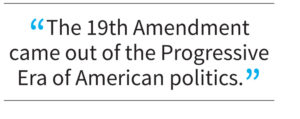Editorial: Americans should now reconsider Equal Rights Amendment
Women’s rights for equality may one day be placed in the U.S. Constitution

Activist Phyllis Schlafly wearing a “Stop ERA” badge, demonstrating with other women against the Equal Rights Amendment in front of the White House.
Earlier this month, we celebrated a milestone in American democracy. Women citizens were well on their way to gaining the right to vote when the 19th Amendment of the United States Constitution was passed by both chambers of Congress a century ago on June 4, 1919. The following year, the amendment was ratified following approval by three-fourths of the state legislatures.
 We can see the amendment’s impact here in Gilroy. Women serve as public officials on our city council and school boards. On a national level, representing us in Washington, D.C., Congressmember Zoe Lofgren is one of 127 women in the House of Representatives, which has for its Speaker of the House Nancy Pelosi of California.
We can see the amendment’s impact here in Gilroy. Women serve as public officials on our city council and school boards. On a national level, representing us in Washington, D.C., Congressmember Zoe Lofgren is one of 127 women in the House of Representatives, which has for its Speaker of the House Nancy Pelosi of California.
The 19th Amendment came out of the Progressive Era of American politics. During the first two decades of the 20th century, social activism and economic reform stirred up in the soul of citizens to make the nation more egalitarian in rights and opportunities. Its passage transformed American politics and inaugurated a new era of leadership in our republic. Historians describe a clear line from its ratification to the passage in the 1960s of Civil Rights laws.
This important anniversary can also inspire us to take a second look at another attempted constitutional amendment focused on gender — the Equal Rights Amendment. In March, House Judiciary Committee Chairman Jerry Nadler held a hearing on the ERA to see if there was interest for a second attempt at its passage. It was only a hearing, but it was historic.
Women’s rights for equality may one day be placed in the U.S. Constitution, ensuring they will not be treated as second-class citizens in matters of law, businesses, and elsewhere.
Here’s a bit of history on the ERA. On March 22, 1972, the U.S. Senate passed the Equal Rights Amendment and sent it to the states for ratification, which required 38 states, or a three-fourths majority, to become the law of the land. It seemed to be well on its way to becoming law. Then a conservative backlash against feminism caused many state legislators to shy away from voting in its favor. Chief among the ERA’s opponents was constitutional lawyer Phyllis Schlafly who organized a “STOP ERA” campaign. STOP was an acronym for “Stop Taking Our Privileges.” Schlafly believed the amendment would cause women to lose certain gender-related privileges including “dependent wife” benefits under Social Security, separate restrooms for males and females, and exemptions from the military draft.
Schlafly, who died in 2016, represents a by-gone era. Her fight against the ERA brought its demise on a deadline of midnight June 30, 1982 when it fell three states short of the required 38 states needed for ratification. In 1975, a Gallop poll showed 58 percent of Americans approved the amendment, with, ironically, more men favoring it than women. In 2016, according to a poll conducted by market research firm DB5, 94 percent of Americans polled support passage of the ERA.
The issue of equality for women has a long history in America. Abagail Adams wrote in a letter dated March 31, 1776 to her husband, John Adams, while he debated for independence in the Second Continental Congress: “In the new code of laws which I suppose it will be necessary for you to make, I desire you would remember the ladies and be more generous and favorable to them than your ancestors. Do not put such unlimited power into the hands of the husbands. Remember, all men would be tyrants if they could. If particular care and attention is not paid to the ladies, we are determined to foment a rebellion, and will not hold ourselves bound by any laws in which we have no voice or representation.”
The ERA, if it enters the Constitution, will enable Abagail Adam’s plea to be met with a guarantee of equal legal rights for all American citizens regardless of gender.
The result will be to end the distinctions in law between men in women in matters including divorce, property and employment. With such overwhelming support currently for this amendment necessary for women’s rights, it’s time for American leaders to give renewed consideration at its possible passage.
- Editorial: Prop 1 passes, addresses unhoused and mental health - April 5, 2024
- Editorial: Stay vigilant of online disinformation during election year - March 22, 2024
- Editorial: Stay vigilant of online disinformation during election year - March 17, 2024
